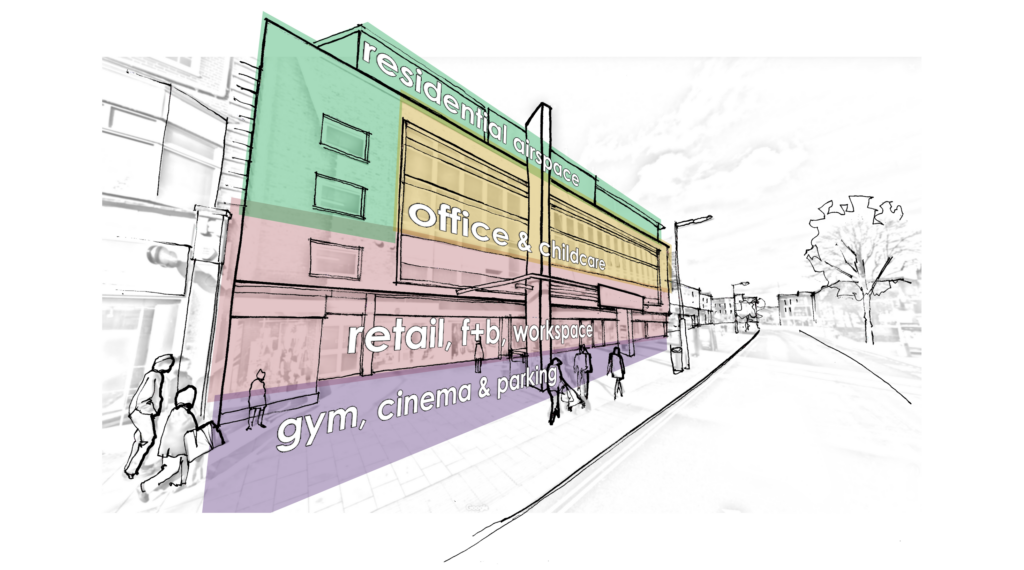Unfortunately for many department stores, the pandemic has been a final blow in the battle with online retail, spiralling real estate costs and difficulty serving up physical retail that is consistently experiential, engaging and adaptable. Stores that we thought would be with us for generations to come are shuttering their doors permanently, with Debenhams among the latest casualties. Unfortunately, very few of these have been reoccupied because the large sales spaces that are left behind are risky and difficult to fill with other retailers alone.
So, what is to become of these extinct department stores? Clearly something needs to, because space that is no longer fit for purpose has a materially adverse effect on society. Mark Burlton, MD of Cross Border Retail Ltd, a global independent retail real estate business agrees. “Even though many have heritage and are significant landmarks to which people hold an attachment, empty or abandoned buildings emit a sense of local economic distress and impact the perception of the surrounding area.”
This is when we can draw inspiration from the past. For hundreds of years, our high streets were buzzing and multi-faceted hubs, serving the local community with a thriving mix of retail, residential, services and hospitality. Over time, retail cannibalised these and the bubble has now burst.
Nigel Collett, CEO of architecture, design and cost management consultancy, the rpa:group states that what the pandemic has emphasised, is the value of community. “During lockdown, we have spent an unimaginable amount of time in our own neighbourhoods, relying far more heavily on local shops and services during this time.” He adds that this feeds into something referred to as hyper localisation, where the services providers and retailers of a community can directly understand and respond to the needs of the people living within it. “As the new normal will see many more of us working flexibly and spending more time at our homes and surrounds, it is the right time to reintroduce more community relevance and empty department stores can help,” he says.
🏆
The 2024 Creative Retail Awards are open for entries.
The Creative Retail Awards are much more than a mere accolade; they represent the pinnacle of achievement in the retail industry. Garnering a nomination or winning one of these awards is a testament to innovation, excellence, and leadership.
www.creativeretailawards.com
This is because as we live a more local existence, our essential needs all need to be met and there is still a requirement for some retail, but it will be condensed. There is also opportunity for the introduction of more pop-up, adaptable event spaces, leisure and hospitality and the provision of fitness and healthcare centres. With flexible working becoming the norm, there is going to be a need for co-working spaces and “business hubs” and childcare facilities to support these, which can be accommodated by vacant department stores. “Large empty stores are usually spread over three of four floors and the space can be carefully divided up. Natural daylight is a challenge as their floor plates tend to be large, but there is scope to introduce light-wells, which make the spaces more versatile”, states Nigel.

“Structurally, many department store buildings having flat roofs, and there is opportunity to build onto these and have outdoor entertainment spaces and roof gardens or airspace hotels or residential units,” adds Nigel. Mark agrees “Airspace construction tends to be more modular and more easily supported by the existing structure of the building. Including residential will bring more people back into towns and city centres, which is what we need.”
Like anything, there are challenges that need to be overcome.
At the onset, a detailed study would need to be carried out to foresee exactly what the needs of the local community surrounding the empty store are and to prevent any replacement being a “five minute wonder”, as Mark puts it. “Staying relevant and responding to these is the most important first step, to ensure the social and economic benefits of repurposing the retail space. A local solution needs to be taken into account and this will result in diverse outcomes”, explains Mark.
As an example, the old Debenhams site that occupied 80,000 square feet in London’s Southside Shopping Mall is being transformed into London’s first active entertainment venue, which includes a Japanese E-karting area, bowling lanes and various hospitality offerings. Further afield, an old Macys store has been transformed into a secondary school. “In both of these instances, how these buildings are repurposed is in direct relation to answering a local need,” states Nigel.
Like anything, there are challenges that need to be overcome. Mark warns that landlords will need to be convinced that a change of use is in their best financial interest. “Local councils need to lend their support to help uplift the area. From a planning perspective, the recent government guidelines stating that planning permission is not needed for change of use needs to be approached with caution.” Nigel agrees and adds “Architects can help ensure that the character of the building is not lost and that the space is divided and utilised in the best way possible, with full safety and quality practices in place.“
We also cannot ignore the fact that repurposing multi-level retail stores is expensive and architecturally challenging and all the more reason why an experienced architect is essential. And yet, done properly, these present a strong opportunity to transform dead spaces into engaging and commercially viable ones that are adaptable and future proof, no matter what may lie ahead.















